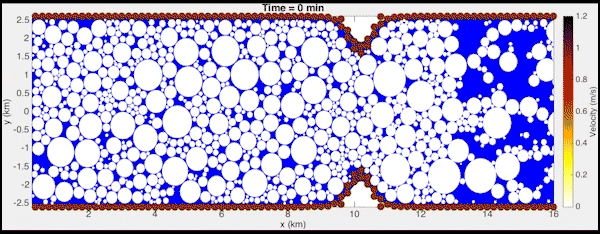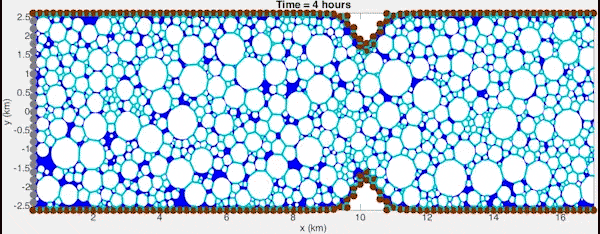Stunning simulations reveal the shock waves that cause chunks of ice to calve
New computer simulations reveal the shock wave created when a chunk of ice breaks off a glacier. This shock wave causes sea ice to shift and can even spur ‘widespread fracture,’ increasing the chances of subsequent breakage events. Understanding these processes could help scientists to better predict how melting ice will contribute to sea-level rise.

The new study from California Institute of Technology examined the effect of the ‘melange’ breakup on iceberg calving – or the process of shedding chunks of ice.
Melange is a ‘floating aggregation of sea ice and icebergs,’ and scientists have long speculated that it may apply enough force on a glacier’s terminus to suppress calving.
In the winter, the icebergs that make up the melange freeze together, creating a ‘frozen iceberg logjam’ that prevents more material from breaking off.
But, as the weather gets warmer, the sea ice begins to thin, eventually allowing for the first calving event in the summer.
The new animation from Caltech reveals the effect of this process.
‘I developed a computer model that stimulates how the first iceberg calving of the warm season creates a shock wave that travels through the jammed melange, breaking it up,’ says Alexander Robel, a National Oceanic and Atmospheric Administration Postdoctoral Scholar and Stanback Postdoctoral Scholar at Caltech.
The simulations are made to resemble the fjords in Greenland.

As the weather gets warmer, the sea ice begins to thin, eventually allowing for the first calving event in the summer. The animation shows how melange responds to pressure applied by the movement of a glacier
These are narrow channels of water prone to trapping melange.
Not only does the spring sea-ice breakup rely on the thickness of the ice in within the melange, but the simulations revealed the shape of the channel plays a role as well.
When the first calving event happens, it sends a shock wave through the cluster of ice.
At first, it causes compression, which later leads to slow expansion.
As a result, the event can initiate widespread breakage of the sea ice.
This reduces much of the pressure on the glacier terminus, increasing the risk of further calving.
The process could eventually lead to rapidly rising sea levels, Robel explains.
‘If the rate of iceberg calving from the Greenland and Antarctic Ice Sheets accelerates, sea level rise may also accelerate to rates that could reach several metres per century over the next several centuries,’ Robel wrote in the study, published to Nature Communications.
‘Ocean and atmosphere warming in the Arctic have already caused longer periods of sea-ice-free conditions, which may lead to a transition from currently slow calving, predominantly occurring in the summer to rapid calving, occurring throughout the year.’
There is, however, also the possibility that the increased runoff from the melting ice could create a layer of cold, fresh water, spurring the formation of more sea ice.

